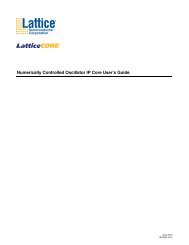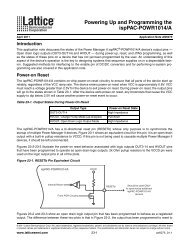DS1036 - Platform Manager Data Sheet - Lattice Semiconductor
DS1036 - Platform Manager Data Sheet - Lattice Semiconductor
DS1036 - Platform Manager Data Sheet - Lattice Semiconductor
You also want an ePaper? Increase the reach of your titles
YUMPU automatically turns print PDFs into web optimized ePapers that Google loves.
Figure 53. TAP States<br />
1<br />
0<br />
70<br />
<strong>Platform</strong> <strong>Manager</strong> <strong>Data</strong> <strong>Sheet</strong><br />
When the correct logic sequence is applied to the PTMS and PTCK inputs, the TAP will exit the Test-Logic-Reset<br />
state and move to the desired state. The next state after Test-Logic-Reset is Run-Test/Idle. Until a data or instruction<br />
shift is performed, no action will occur in Run-Test/Idle (steady state = idle). After Run-Test/Idle, either a data or<br />
instruction shift is performed. The states of the <strong>Data</strong> and Instruction Register blocks are identical to each other differing<br />
only in their entry points. When either block is entered, the first action is a capture operation. For the <strong>Data</strong><br />
Registers, the Capture-DR state is very simple: it captures (parallel loads) data onto the selected serial data path<br />
(previously chosen with the appropriate instruction). For the Instruction Register, the Capture-IR state will always<br />
load the IDCODE instruction. It will always enable the ID Register for readout if no other instruction is loaded prior<br />
to a Shift-DR operation. This, in conjunction with mandated bit codes, allows a “blind” interrogation of any device in<br />
a compliant IEEE 1149.1 serial chain. From the Capture state, the TAP transitions to either the Shift or Exit1 state.<br />
Normally the Shift state follows the Capture state so that test data or status information can be shifted out or new<br />
data shifted in. Following the Shift state, the TAP either returns to the Run-Test/Idle state via the Exit1 and Update<br />
states or enters the Pause state via Exit1. The Pause state is used to temporarily suspend the shifting of data<br />
through either the <strong>Data</strong> or Instruction Register while an external operation is performed. From the Pause state,<br />
shifting can resume by reentering the Shift state via the Exit2 state or be terminated by entering the Run-Test/Idle<br />
state via the Exit2 and Update states. If the proper instruction is shifted in during a Shift-IR operation, the next entry<br />
into Run-Test/Idle initiates the test mode (steady state = test). This is when the device is actually programmed,<br />
erased or verified. All other instructions are executed in the Update state.<br />
Test Instructions<br />
Test-Logic-Rst<br />
0<br />
1 1 1<br />
Run-Test/Idle Select-DR-Scan Select-IR-Scan<br />
0 0<br />
1 1<br />
Capture-DR Capture-IR<br />
0 0<br />
Shift-DR 0 Shift-IR 0<br />
1 1<br />
1 1<br />
Exit1-DR Exit1-IR<br />
0 0<br />
Pause-DR 0 Pause-IR 0<br />
1 1<br />
0 0<br />
Exit2-DR Exit2-IR<br />
1 1<br />
Update-DR Update-IR<br />
1 0 1 0<br />
Note: The value shown adjacent to each state transition in this figure<br />
represents the signal present at PTMS at the time of a rising edge at PTCK.<br />
Like data registers, the IEEE 1149.1 standard also mandates the inclusion of certain instructions. It outlines the<br />
function of three required and six optional instructions. Any additional instructions are left exclusively for the manufacturer<br />
to determine. The instruction word length is not mandated other than to be a minimum of two bits, with only<br />
the BYPASS and EXTEST instruction code patterns being specifically called out (all ones and all zeroes respectively).<br />
The <strong>Platform</strong> <strong>Manager</strong> contains the required minimum instruction set as well as one from the optional<br />
instruction set. In addition, there are several proprietary instructions that allow the device to be configured and verified.<br />
Table 22 lists the instructions supported by the <strong>Platform</strong> <strong>Manager</strong> JTAG Test Access Port (TAP) controller:









